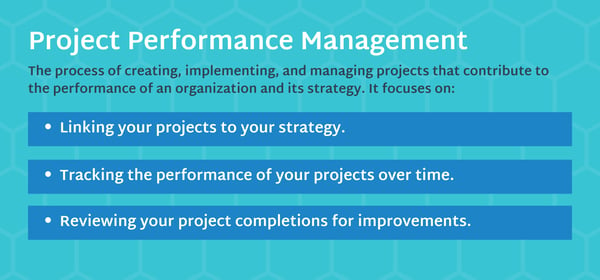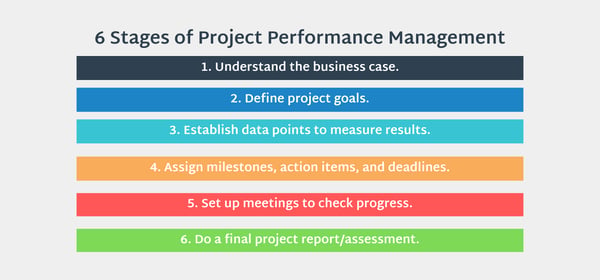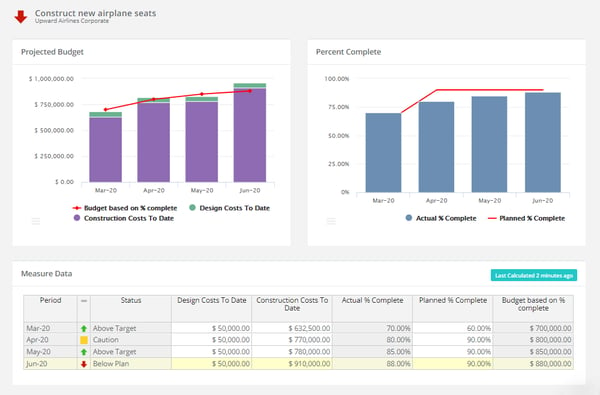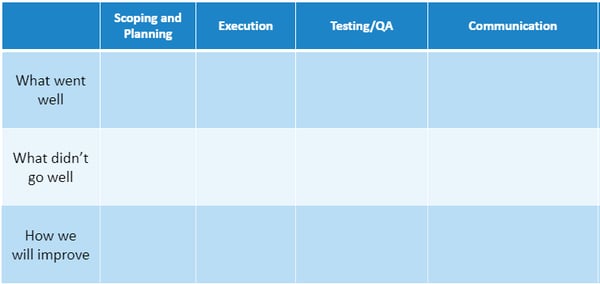
Every project seems crucial – until it’s not.
Too often, businesses undertake projects believing they will be beneficial for the organization, only to see them fail to deliver what was expected. According to PMI, 9.9% of every dollar is wasted on poor project management and execution. As a result, organizations waste an enormous amount of resources, including time, money, and personnel – executing tasks that won’t produce a return on investment.
Project management, a well-developed field around organizing and executing the tasks involved in a project, is certainly key to pulling off a project successfully, but it must also be accompanied by an element of project performance management, a larger process that ensures strategic success.
Project performance management is the process of creating, implementing, and managing projects that contribute to the performance of an organization and its strategy. Rather than focusing on task execution, project performance management is about the bigger picture.

It focuses on three areas to ensure every project produces a business benefit:
Project performance management is part of the larger performance management process; essentially, it’s all about leveraging your projects to execute your strategy.
Continuously carrying out projects that fail to contribute to strategic objectives is not only a waste of time and resources, but also undermines your organization’s ability to stay competitive.
Most executive leaders believe their projects are performing well, when in fact, one in three projects don’t meet their goals. Organizations that actively manage projects to align with strategy (and execute them well) means they’re doing better than many of their competitors at allocating resources in a way that directly contributes to the organization’s well-being. They are spending wisely, increasing profitability, saving time, and reducing waste.
With a defined management and reporting process, you can track and adjust along the way.
They are also creating a culture that is focused on organizational outcomes rather than project outcomes. A substantial amount of money is spent on these projects—sometimes as much as 20%–30% of an organization’s budget. Allowing projects to veer off course to meet departmental needs rather than organizational goals diminishes your ability to achieve those larger goals over time. Without a project performance management process in place, low-performing projects could become the norm.
Organizational performance management (also called corporate performance management) is the concept of managing the strategy of the entire organization: What are its goals? How will you measure them? What actions will you take to achieve improved results?
Organizational performance management deals entirely with how you communicate, align around, and execute your strategy. The Balanced Scorecard (a strategic planning and management system that takes several organizational viewpoints in addition to the financial angle into account), EFQM Excellence Model, MPO, and Six Sigma, are all frameworks used to help manage corporate performance.
Project performance management is a subset of organizational performance management.
Many organizations have an OPM system that includes projects. If you have a separate project management office, make sure they are working closely with your OPM team. Only 41% of organizations with an enterprise-wide project management office report that it is highly aligned to the organization's strategy.
Employee performance management is a subset of human resources and project resource management that seeks to improve employee productivity, satisfaction, and operational capability. This area focuses on competency building, closing skill gaps, and guiding employees careers, promotions, raises, and normal reviews. It is related to project performance management and organizational performance management in the sense that you need qualified employees to run projects, and you need to make sure you have the right staff with the right skills for your overall strategy.
Even if a project is completed on time and on target as far as budget and scope, that’s not enough to declare it a success. The true measure of a successful project is if it meets that criteria – and whether or not it actually contributes to a strategic business objective. To go beyond managing the technical elements and keep projects on track strategically, follow the six steps below.

Most organizations have more projects than they can handle. Too often, projects are proposed not for the good of the organization but to benefit a particular department. For example, an IT department might want to purchase and implement a specific software solution because it has cool features, not because it will help accomplish a business goal.
The value of all projects should be questioned before putting them into play. Thus, every project needs a well-defined business case: why are you doing it? At this stage you should also consider alternatives to the project you’re proposing, and whether or not your proposition will generate the most value.
To simplify this step, create a “business plan” template you can use across projects, outlining the goals, costs, and timing of each project (including the indirect cost of people’s time), and show how each project will drive better results over time. Review this document often throughout the execution phase.
Goals provide clear direction for projects, specifying exactly what you expect they will accomplish. Be realistic about what the project will really support. Some organizations put rules in place that prevent projects from linking to more than two or three goals (to keep the projects focused). Many municipal organizations require departments to link projects to the organization’s current KPIs to show how investing in a project will drive long-term results. That way, all projects that get funded are clearly linked to the strategy in a transparent way.
There’s a lot written about the “triple constraints” of project management: time, scope, and cost:
These data points should always be part of your performance management process, and you should be able to track them with ease. But there will also be measures outside of these that will change depending on the goals your project is trying to improve. For example, your organization may have a long-term strategic vision to become more sustainable.
A related project might be to implement an Internet of Things monitoring system to reduce your organization’s water use. In addition to managing the traditional data points listed above, this particular project would have a data point around water use specifically. How much water will you save as a result of this project? Such an improvement should be directly impacting a data point that already exists in the organizational strategy.
The business environment changes quickly, which is why it’s imperative to continuously track progress toward all your data points (not just project-driven measures). If, for instance, a new technology has entered the market that affects your organization or project, you need to be nimble and aware, and ready to make a change in your data points.

Projects have many different steps, and while a project may have a single project manager, the tasks associated with reaching different milestones may be owned by different individuals. Whether you’re using an agile approach or a waterfall approach to project management, the mini-steps within a project all need to be managed well.

The deadlines within these projects may have dependencies that cause major disruptions. For instance, you may not be able to add new features to a software without the foundations of the database in place. Or you may not be able to pave or light a construction tunnel if the walls are not stable and equipment is moved. It is worth preparing all the steps in your projects and understanding the interrelationships and dependencies if they exist.
Never assume projects will run smoothly. Regular meetings are a good forum for working out checking on progress using project portfolio optimization is highly beneficial. Your project may have run into a technical challenge that forces a decision or a change in scope, timing, or cost that could impact all the other project milestones. Or, your organization may be experiencing budget cuts or some other business uncertainty that is completely unrelated to the project, but could still cause a change or delay to its execution.
You’ll also want to create management reports to show progress. Reports should include project start and end dates, percent complete, spending to date, and any key steps and checkpoints (milestones) in the project. Sometimes, the easiest way to show this information is through a Gantt chart.

Meetings about individual projects should occur fairly frequently, even daily or weekly depending on the project. Larger organizational meetings usually occur monthly or quarterly to discuss the projects within the context of the strategy.
No matter what the project, it’s important to do a wrap-up at the end, signaling you have moved from project implementation to “business as usual”. For example, a software implementation could spiral into a never-ending project if you consider that there will always be new software releases and new features to add. Your project team needs to have clear boundaries on when to stop the project and transition the management of the software to the sales and marketing teams.
The same goes for transitioning from a construction project to a maintenance project. The Big Dig in Boston took 13 years, and by the time it was complete, there was already maintenance ongoing to the roads, bridges, and tunnels involved with the project.
At the end of each project, it’s helpful to pull together a project summary and an after-action review (AAR). The AAR is essentially made up of two parts:
The discussion should include members of the leadership team and departments who benefited from the implementation of the project.
You should be measuring the results of each of your projects as they finish, and looking at your portfolio of projects each month or quarter. When projects finish, track their effectiveness and AAR, and use the information to improve future projects. When you review your portfolio, it should be for strategic alignment and effective use of resources within the context of the bigger strategy. Create a table to help guide your review, thinking about each individual step of the project process.

It’s to be expected that your methods of performance management system will change over time. What information do your leaders want to see? It may be different than what you presented for a previous project, and you may need to make adjustments for different audiences. This is normal, and you should be prepared to adapt.
That goes for the tools you’re using (ideally, software) to carry out the process as well. It should be flexible enough to evolve with your needs, while serving as a hub for all the strategic data you’re gathering across your organization.
An organization’s competitiveness depends in part on its ability to complete projects profitably. The performance management process ensures that projects remain profitable not just in the technical sense, but also in a strategic sense, so that every project drives organizational improvement.
Companies that develop a comprehensive approach to align projects to their business strategy, and then track and manage them well, are better positioned to reach their goals because they can distill high-level strategic visions into tangible actions. That’s what drives high-performing organizations forward – and sets them apart from the competition.
Ted is a founder and managing partner at ClearPoint Strategy. Ted and his team of performance management experts help organizations around the world improve their management reporting process. When he’s not solving reporting challenges, you’ll find Ted grilling outdoors with his wife and two children.
“Someday my prince will come,” was a big phrase throughout my Disney-filled childhood.
 by Grace Pinegar
by Grace Pinegar
With any project, big or small, someone has to take the lead.
 by Alexa Drake
by Alexa Drake
Do you freeze when someone asks about your strengths and skills?
 by Grace Pinegar
by Grace Pinegar
“Someday my prince will come,” was a big phrase throughout my Disney-filled childhood.
 by Grace Pinegar
by Grace Pinegar
With any project, big or small, someone has to take the lead.
 by Alexa Drake
by Alexa Drake


